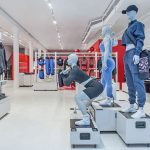Looking back at the first decade of the new millennium reads like a giant Bell Curve, with the decade starting and ending with two of the most devastating events in recent American history: 9/11 and The Great Recession. However, the key events that transpired between these two bookends have transformed the sporting goods industry into a very different place than it was in the 1990’s — or the last decade — and have set the tone for even more contrast in the decade ahead.
The decade, which started with the bursting of the Internet bubble and ended with the bursting of the real estate bubble, also saw a “pop” in the retail bubble as well as a market that became over-retailed during a period of conspicuous consumption and gave way to retail bankruptcies, store closures, retail lease renegotiations and tight inventories — and the Internet finally came into its own as a very robust retail platform.
The sporting goods industry picked up energy in the first half of the decade with numerous IPO’s that saw the rise of two national sporting goods retail chains and a number of vendor-side consolidators that created new efficiencies and synergies to service the ever more powerful chains through expanded stables of brands and products.
But the back half of the decade started to see the divesture of some of the deals and a move by many public companies to again go private in the face of restrictive — and expensive — government oversight.
The decade ended with a failed merger between The Finish Line and Genesco, Inc. that may have re-aligned the shape of the mall, but it was a flurry of retail bankruptcies in 2009 and the arrival of the Internet as a driving force in retail shopping that are again re-shaping the retail landscape across the country. Likewise, moves by the largest brand consolidators like Nike, Inc., VF Corp. and others to a more vertical model-including ownedretail and Internet sales-were designed to bring the consumer closer to the brand and throw more to the bottom line and are changing the rules for the marketplace for the decade ahead.
The emergence of Under Armour and the closely-linked rise of performance apparel stand as two of the biggest stories in the sporting goods industry during the first decade of the new millennium.
Those trends were at the top of the list when the sports and outdoor market responded to the latest SGB Question put out by The SportsOneSource to query the trade on the brands, innovations or trends that galvanized and reshaped the industry over the past decade.
Other events mentioned were the emergence of new technologies such as the GPS and the iPod, the growing popularity of action sports across America, the rise and fall of Heelys and Crocs, the endless consolidation among both vendors and stores, and the expansion of women's-specific gear, sports medicine, and helmets/safety products. Some pointed to how lighter materials and new processes have led to innovations on the footwear and equipment side. A few lamented that the decade should go down as one largely devoid of innovation. Others touted it as a decade on technical and materials innovation that will change the way the market sells product for the next decade.
But what clearly stood out was the number of fans and admirers paying tribute to Under Armour's role in establishing the compression apparel category. “Under Armour-by far-has made the biggest impact in the biz,” said Marc Gustafson, business development/ sales, Denver Athletic. “With the advent/innovation of moisture management properties and with every other brand following suit, UA has definitely made a significant mark on the industry.”
“Not only did they create a great product line, they ended up creating a whole market. Even though they aren't the only one with performance apparel, they are still the best,” added Mike Bruno, General Manager, Grogan- Marciano Sporting Goods. Michael J. McGuinn, SVP GMM Footwear/Active Apparel at The Sports Authority, said Under Armour “challenged the status quo and made everyone in the industry better for it.”
He called the overall development of performance apparel the biggest trend over the last decade. “Everyone in the industry realized that to survive you needed to be in the performance apparel business, whether you are an Active Apparel brand or an Outdoor Lifestyle brand,” McGuinn said.
Peter Foley, chief technology officer at SKYDEX Technologies, said the big win for the industry achieved through Under Armour's success was legitimizing apparel as equipment in the customer's eyes.
“Though not a new idea or effort, Under Armour's use of NFL players did what other people in sporting goods-including Nike-had been trying to do for some years,” said Foley, who formally worked in advanced product development for Reebok and Rollerblade. “After all, breathable, wicking, hydrophobic stretch fabrics had been around for many years before Under Armour, and yet only a few high end runners, cyclists and skiers spent the additional money to buy these fabrics. But it was Under Armour and their use of the NFL that made the category more than a niche and established previously unthought-of price points for mainstream athletic apparel.”
Jim Baker, sourcing and merchandising manager for The Neff Co., further said the acceptance of performance fabrics overall has energized many apparel categories. “Whether you consider compression, moisture wicking, anti-microbial, UV protection and others, these treatments have worked their way into every facet of the sporting goods market,” said Baker. “Whether it is garments alone, pad/equipment lining or underwear there are a variety of products for ever sporting category that include these materials.”
Perhaps to a lesser degree, equipment and footwear has likewise evolved significantly in the past decade due to the use of stronger and lighter materials made possible by new manufacturing equipment and techniques.
“These innovations enhance the athlete's abilities across a wide range of sporting activities,” said a designer at a major athletic footwear/apparel vendor who requested anonymity.
Not surprisingly, the industry’s largest brand was also mentioned by a few, but the absence of Nike at the top of most lists belies the brand’s move to near-total dominance of the athletic footwear category over the last ten years. Perhaps the brand that many see as the most innovative over time hasn’t delivered the big wins that changed the market as dramatically as they once did, but few could argue that the dominance of Nike in design, technical innovation and business processes came as a result of the brand’s efforts to establish excellence in these areas as commonplace. What is now expected of Nike would be a major win for a smaller brand.
Ted Kushion, merchandise manager at Gazelle Sports in Kalamazoo, MI, noted how Nike Free changed how running shoe companies look at accommodating the foot's needs in the running gait. TSA's McGuinn highlighted how Nike Shox elevated the expression “visible technology” beyond conventional means in a footwear mid-sole.
Still, the brands and trends mentioned most often by the Question respondents were those that came and went, such as Crocs and Heelys, or the move to low profile fashion athletic product. And some are already assessing the toning/shaping category for its potential as an industrychanging trend for the next decade — or its potential to be just another short-term fad.
One veteran footwear buyer who wished to remain anonymous regretfully could only find two items over the last decade that made it into his “hard to beat last year book” – Crocs and Heelys.
“Sweeping trends and hot brands are supposed to be there and Heelys and Crocs rang the cash register! They made a difference in business, not just protected what they did last year,” said the buyer. “Under Armour also rang the machine and added sales. I cannot say that toning footwear will match the impact of the cross trainer.”
Robert Mangione, VP of sales and marketing, Birki's, nonetheless noted how the emergence of skate as an alternative oxford look and the wellness category as an alternative performance classification are providing new opportunities to retailers.
“The last trend is a continuance of fashion and athletic influences creating hybrid opportunities for existing players and all new comers,” said Mangione.
Other brands receiving praise included Keen, Smartwool, Converse, Puma and how GBMI brought fashion athletic looks to the market with the Diesel brand.
Scott Mellin, CEO, Factory Design Labs, noted how The North Face went from bankruptcy “to the global leader in the outdoor business in 10 years.” Mellin also noted how Oakley had “clearly become a defining brand in nearly every sport it touches.”
Some chose to look at more global themes. Many noted the ongoing consolidation on the vendor and retail side with many regretting the repercussions.
Said Doug Hoschek, CEO, Portland Woolen Mills, “The trends of the first decade of the new century are now galvanized into bigger corporations owning most of the important brands. This has created a monopoly of retail dollars that are now showing deep sign of the innovation curve losing what has been the lifeline of sporting goods.”
Said a CEO of a regional team dealer with some retail outlets: “The proliferation of the big boxes has changed the playing field. We are geared to compete with their offensive.” Said an anonymous respondent, “The Big get Bigger, the small go away.”
Some mentioned how the advent of online retailing has had a profound impact on reshaping the way consumers buy and retailers sell. The most recent Holiday shopping season will be a testimonial to the rise of the Internet as an industry-changing shopping destination of choice for many consumers. It has become the new mall, with consumers hanging out online and “tweeting” as they shop instead of chatting about trends and bargains as they stroll the mall’s now emptier corridors.
“Ecommerce sites in the 90's were few and far between and this decade has really created a shift from traditional brick and mortar retailing to online,” said Robert Reynolds, president, Dunlop Sports Group Americas.
Innovation in systems and processes were also mentioned as game-changing elements of the last decade.
Robert Zetelski, national sales manager for Rio Brands, said the move from domestic manufacturing and inventory to China sourcing and direct importing clearly accelerated during the decade. “Timing, pricing and methods of purchasing have seen the largest changes in retail sporting goods,” said Zetelski.
Around the same theme, a head buyer at a regional sporting goods chain noted the shift toward greater use of replenishment orders rather than futures-particularly in footwear and apparel.
“Early in the decade we had virtually no replenishment. Today it's not enough, but it's growing,” said the buyer. “This growth will allow us to capitalize on more trends and maximize more businesses.”
But the buyer also pointed to some other positive developments for full-line sporting goods stores. These includedbusinesses such as pro line golf and paddle sports becoming much bigger departments at full-line sporting goods stores in a shift away from specialty shops. At the same time, a de-emphasis by discounters such as Kmart and Walmart has helped many outdoor categories become bigger opportunities for sporting goods as well as larger-format outdoor stores. He also pointed to the greater application of technology to all areas of the sporting goods business, from apparel (Under Armour), baseball, outdoors GPS radios, game cameras, golf rangefinders, oversized clubs, etc. Indeed, several others noticed how consumers have embraced technological advances.
Gazelle Sports' Kushion noted how the iPod “changed how America trains, forcing apparel companies to design around these devices.” Eric Roesinger, international category business manager for Yakima Products, pointed to how carbon and suspension technology are making bikes more functional and fashionable. He also said Electra Townies “are breathing life into the fun, accessible and inclusive side of the sport, and that’s what’s needed more than anything right now — core participants.”
Dominic Petit, general manager/president for Velocity Outdoor LLC, believes the decade belonged to personal hydration, from packs with reservoirs to the bottle revolution on BPA.
“No one was left untouched by it, from soccer moms to the most elite athlete. It changed the way we view our planet’s most valuable resource,” said Petit. Indeed, a few mentioned how the environment began playing a much bigger role in product and processes over the last ten years.
Nicholaus Isaac, store manager at Backcountry Gear Ltd., points to lightweight and ultralight backpacking movement.
“For a time, it seemed that there was such a strong push towards the Ultralight movement that durability and longevity of products was paying the price,” said Isaac. “Over the past couple years, I feel that there is more of a balance between light weight and durability a perfect compromise for the consumer.”
Jon Pysczynski, product specialist, W.L. Gore and Associates, agreed that durability became even more important to consumers in the latter part of the decade.
“As consumers have become more sophisticated and demanding with regard to their gear, it is has become critical for all products, including footwear and apparel, to be durable and built to last,” said Pysczynski.
“People today are giving more thought to their purchases, especially when it comes to the outdoors. They are looking for quality over the long term and brands they can trust; brands that will be here today, not gone tomorrow.”
Others cited the emergence of Nintendo’s Wii Fit system as an important driver for the decade ahead as it pulls more people off the couches and onto their feet. This is clearly not Jack Lalanne anymore.
In fitness, Brian Drennen, VP Sales for Everlast Worldwide, noted how the Perfect Pushup has become a big winner across channels and price points. He also noted how the Wii Fit “has gained momentum to carry us into the next decade as a popular exercise solution for the entire family.”
Robert Brooks, president, Robert Brooks Associates noted the growth in the fitness areas of aerobic and anaerobic products (treadmills, elliptical machines, bikes, bow power gyms), TV items such as ab machines, sit up/pull up products, as well as strength and toning products.
Some growing activities mentioned by the respondents included road cycling, triathlons, freeride skiing, paintball and cheerleading as well as tailgating. Several mentioned the rise in skateboarding and other extreme sports as well as the continued decline of inline skating that began toward the end of the previous decade.
Bill Byrne, Lead Media Strategist, BBPR, said the rise of snowboarding in particularly had influenced many categories.
“Sliding sideways continues to be a global force in pop culture, a media darling at the Olympics and a major boon to the ski industry general – both in terms of ticket sales and shaping product design for nonsnowboard brands,” said Byrne.
Among younger participants, Mike May, director of communications, SGMA, noted how competition-especially on travel teams for both boys and girls-has become more intense, which has caused young athletes to specialize in one sport at a younger age. He also pointed to a renewed awareness of the importance of daily P.E. in U.S. schools to help combat expanding waistlines (and type 2 diabetes) among children.
But some believe some of the biggest gains over the last decade were seen in the rise of the active female consumer as a driving force for the market and the development of women's-specific product and accompanying marketing. The market can no longer “pink it and shrink it” to get the job done.
“Retailers such as Title Nine Sports, Athleta and Lucy provided access to women looking for product just for them and brands such as ISIS and Moving Comfort let women know there were people paying attention to them,” said Carolyn Cooke, president, Isis for Women.
Richard Fredericks, president, H.R.F. & Associates, said the decade showed the opportunity in targeting active women.
“Women's classes in Yoga, Spinning, Zumba; equipment in all segments of the women's market, and workout machines geared towards women have given women confidence in their abilities and they have paid back the industries involved by purchasing women's performance gear,” said Fredericks. “This trend has produced a hugely successful and profitable segment of the market.”
The big wins over the last decade will clearly shape the next decade as vendors and retailers look for new ways to engage with consumers through a continuous flow of new ideas. Many lamented the trend to big boxes over the last decade, which they felt stymied innovation as chains focused on a planning spreadsheet dominated the marketplace. No longer are regional chains such as Chick’s, Koenig’s, Sports & Rec, and many others that had previously brought innovation and new ideas to the market. But the stores of the future may well be in the hands of the consumer-both figuratively and literally-as technology and the Web play a larger role in how and where America shops.















